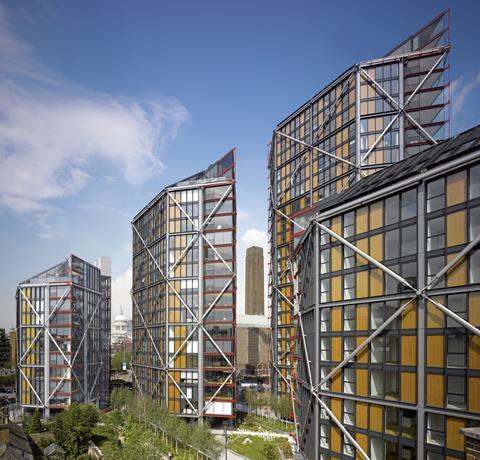Owners of Richard Rogers flats want Tate to shut 10th-floor viewing gallery
The residents of RSHPŌĆÖs Neo Bankside flats have returned to court, arguing that the judge who threw out their objections to Tate ModernŌĆÖs viewing deck was wrong.
They hope to overturn that judgment and put a stop to the ŌĆ£snoopingŌĆØ by visitors at the galleryŌĆÖs Herzog & de Meuron-designed extension.

They say that Mr Justice MannŌĆÖs ŌĆ£mental exerciseŌĆØ in which he imagined them living not in a building with floor-to-ceiling windows but one with ŌĆ£significant vertical and perhaps horizontal breaks to interrupt the inward viewŌĆØ was ŌĆ£hopelessly lacking in definitionŌĆØ.
And they say that he was wrong to have invented a legal principle that they could not establish a nuisance in law if a disturbance with the enjoyment of their homes is caused only because of the buildingŌĆÖs design ŌĆō namely the huge areas of glazing.
He used that principle to dismiss their claims in the High Court in February 2019, a ruling the residents are now attempting to overturn in the Court of Appeal.
They want the Tate to shut the 10th-floor wraparound viewing gallery, or at least the part that overlooks their homes. They complain that the invasion of privacy is blighting their lives.
The Tate trusteesŌĆÖ defence is that the residents bought the flats in full knowledge that a tourist attraction was to be built next door ŌĆō and that simple net curtains could solve the problem.
In the original case, the judge proposed an imaginary building with smaller windows to test arguments about the legal nature of ŌĆ£nuisanceŌĆØ.
This weekŌĆÖs hearing focused on whether the Stirling prize-shortlisted flats were ŌĆ£abnormally sensitive to invasions of privacyŌĆØ due to their floor-to-ceiling windows and being located adjacent to the TateŌĆÖs viewing gallery allowing people to look in.
The residents, whose homes range in value from ┬Ż2m to ┬Ż19m, are seeking to overturn his ruling on a number of grounds.
The defendants are arguing, among other things, that the problems would not have arisen if louvres had been added as set out in the original drawings. A second set of drawings was submitted and approved omitting many of the louvres.
ŌĆ£A significant reduction in these protective measures ŌĆÖdisappeared without commentŌĆÖ,ŌĆØ they noted.
They also argued that since the claimants had ŌĆ£opted for a design of flat and lifestyle choice which invited the privacy invasion, then they had created their own sensitivity and would have to tolerate what the design had createdŌĆØ.
No date has been given for when the courtŌĆÖs decision is to be expected.




























No comments yet